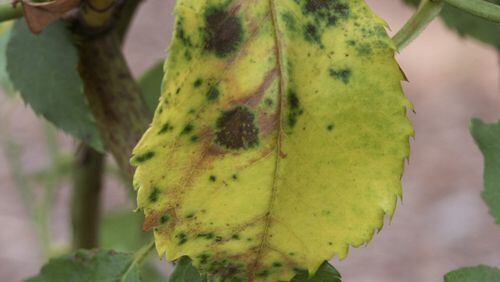Q: My best rose came down with black spot disease. I removed all damaged leaves and sprayed it but overnight it was on other leaves! Lynn Greenwell, Bryan County
A: You need to start alternating fungicides. When you use one product exclusively, black spot fungi develop resistance to it. You'll need to become adept at reading pesticide ingredient labels.
Look for tebuconazole, propiconazole, chlorothalonil, and myclobutanil, choosing three of them. Read the label for application intervals. You should swap chemicals after every two applications. To further prevent black spot on susceptible roses be sure to replace their mulch every fall and avoid overhead irrigation.
Q: My friend has a cabin on a lake. Her boat house attracts an otter whose only purpose there seems to be relieving himself. He keeps returning no matter what she does to discourage him. She read that an otter's natural enemies include bears and lions. The area is bereft of lions and arranging for the services of a bear is difficult. Is there a solution for her "poop dock" visitor? Elizabeth Vantine, email
A: One option for your friend is a motion-activated water sprayer. The otter will get an unexpected bath each time he feels the "need to go". Look online for a Scarecrow Water Sprinkler, an Orbit Yard Enforcer or a Havahart Spray Away.
Q: We have wild grape vines growing in our ivy. We tried pulling them up, but they keep returning. Any other suggestions? Sam Draisen, email
A: Your "wild grape" could be muscadine vines but they might also be porcelain berry vines or perhaps possum grape. All have similar leaves. One of the techniques these wild vines use to survive is to break apart when joints above ground are tugged. So if you simply pull them out of the ivy or shrubbery without pulling out the roots, the vine survives to invade once again. Try gently tugging on the bad vine to find its origination point and then pull it and its roots out of the ground together.
Q: I have a fairly large hole where an old tree trunk has rotted away. Can I plant a viburnum in this existing hole or should I dig a new hole? Renee Rudin, email
A: One factor in the successful planting of trees and shrubs is to minimize the difference between the material the plant is growing in and the soil into which it is planted. If your viburnum is in a pot, the growing medium is very different from your landscape soil. You can plant where the old tree was growing but you need to loosen the soil four feet in all directions around the planting spot first. Wash as much soil as you can off of the plant root ball and straighten out the circling roots that you discover so they grow away from the center. New roots will grow in any direction where they find loose "breathable" soil.






